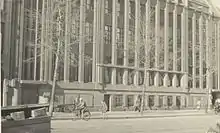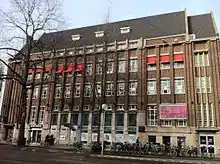Lippmann, Rosenthal & Co.
Lippmann, Rosenthal & Co. or Liro was a Dutch Jewish bank, located at the Nieuwe Spiegelstraat in Amsterdam. During the second World War, the Nazi government of Germany used the name of the bank for a separate branch, used for looting Jews, located at the Sarphatistraat.[1]



This branch was used for robbing the Dutch Jews, mainly living in Amsterdam, of their possessions.[2] Not only bank accounts at other banks were confiscated, Jews were also forced to deposit their art collections, jewels etc. at this bank. [3] If a Jewish family was deported from their home, their possessions were sold. The money was used for various purposes, for instance the financing of the Westerbork transit camp. High level Nazis could pick from the art collections. In addition, important artworks were sent to German museums.[4]
After the war, the original bank had lost its good name, and was finally taken over by another bank, the Hollandse Koopmansbank.
References
- De Groene, Liro Roofbank, 10 december 1997
- Aalders, Gerard. (2004). Nazi looting : the plunder of Dutch Jewry during the Second World War. Oxford: Berg. ISBN 1-85973-722-6. OCLC 53223516.
- Boffey, Daniel. "Dutch museums discover 170 artworks stolen by Nazis". www.lootedart.com. Retrieved 2020-12-18.
The palace’s investigation into tens of thousands of artworks in the House of Orange’s collection brought to light convincing evidence that the owner of the van der Haagen painting, depicting a view of Huis ten Bosch Palace, had been forced to hand it over to a Nazi bank, Lippmann, Rosenthal & Co, in Amsterdam.
- Roet, Avraham. "The Netherlands is still hoarding a massive collection of art looted from Jews by Nazis". Haaretz.com. Archived from the original on 13 September 2017. Retrieved 2020-12-18.
External links